Below is a list of all the animals seen here in the North Carolina Zoo. Click on the name to find out more about each one.
Alligator Snapping Turtle
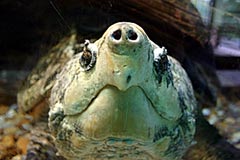
Location: North American, Cypress Swamp
(No description available)
American Alligator
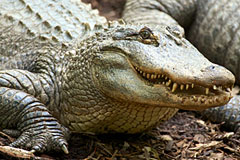
Did you know alligators do not eat during the winter? Between May 1 and Sept. 30, our alligators are fed Saturdays and Sundays only. Feeding times are posted at the exhibit.
Location: North America, Cypress Swamp
American alligators reach lengths up to 15 feet and may weigh over 700 pounds. These meat-eaters lose teeth throughout their lives, and may have 2000-3000 in their lifetime. Their wallows (or “gator holes”) create small aquatic microhabitats for many other animals of the swamp.
Arctic Fox
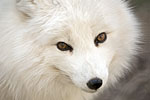
Location: North America, Rocky Coast
These small foxes have snow white fur in the winter and shed out to a short, brown fur in the summer. Change of color provides very effective camouflage. Incredibly hardy, this fox can handle extremely cold temperatures.
Barred Owl
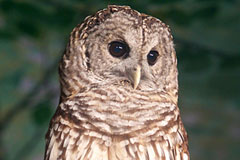
Location: North America, Stream Side
The vocal barred owl is well known for its distinctive call, which sounds like the bird calling “Who cooks for you … who cooks for you all?” They often swallow their prey whole and, after digesting the softer parts, the parts that cannot be digested form into a pellet that is then coughed up. Scientists collect and dissect these pellets and determine what animals are in a habitat based on what the owls are eating.
Bobcat
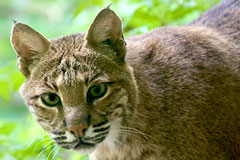
Location: North America, Stream Side
Named for their short tails which appears to be “bobbed”. Even though they are only about twice the size of a housecat, Bobcats are powerful. They stalk their prey in silence, then leap on it from a distance of up to 10 feet! They have excellent vision and hearing to go along with a good sense of smell. Bobcats use their whiskers like fingertips to “feel” prey even in the dark.
Bongo
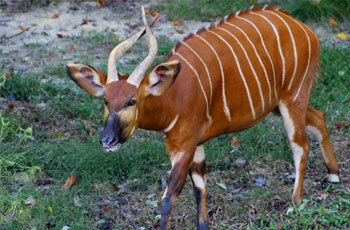
Location: African, Grasslands
The third heaviest African antelope, behind only the giant and common eland and is the largest of the forest antelope. In the wild, they are found in lowland and mountain rainforest with dense undergrowth. However, they do depend on openings in the forest that support the growth of bushes, herbs, and other plants on which the bongo survive. Bongo are colored a rich chestnut brown, with males turning almost completely black with age. They have 12-14 vertical, white stripes from shoulders to flanks. Coat coloration, although bright out of the forest, is very concealing within the forest.
Chimpanzee
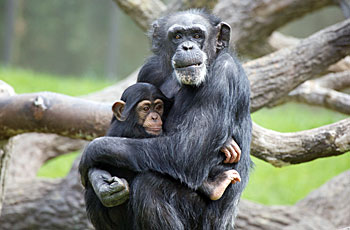
The chimpanzees at Kitera Forest are fed on Saturday and Sunday at 2 p.m.
Location: African, Kitera Forest
Chimpanzees are intelligent and very social animals. They live in large troops that may number 50 individuals or more. Troops are led by a dominant, or alpha, male and female, and the hierarchy is maintained through posture, facial expressions, sounds, gestures and fights. Tool use is well documented in chimpanzees, with chimps creating tools to help them find food (using a small twig to fish out termites or smashing nuts that are too hard to crack between two rocks), obtain and transport water by chewing leaves and then soaking up water with them, and even using rocks and limbs to threaten other animals.
Common Waterbuck
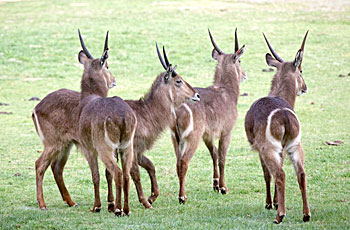
Location: African, Grasslands
They are always found close to permanent water, usually in marsh areas and reed beds, and will flee to the water and even submerge themselves to elude predators. Waterbuck are gregarious animals, living in small herds of 5-30 animals led by large adult male. Their promary diet is grass, with some leaves, shrubs, shoots, and buds. They tend to eat grasses other grazing animals ignore which allows them to mix with zebras and wildebeest.
Copperhead
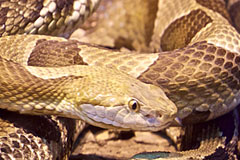
Location: North America, Stream Side
Copperheads are ovoviviparous – giving birth to live young after the young develop inside the body of the mother. The mother produces a large, yolk-filled egg that is kept in the reproductive tract during development. During this time, the embryo receives no nourishment from the mother (although inside her) – instead, receives it from the yolk sac. Young are born within a membranous sac that they emerge from immediately after being expelled from the mother. There is no direct care by the mother. Young are born with a bright yellow tail that they use as a lure for small prey items.
Cougar
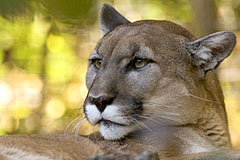
Location: North America, Cypress Swamp
Are the largest of the small cats. All large cats can roar, while small cats cannot. Cubs are born with blue eyes and spotted coats (for camouflage) – spots disappear by age 2. Can spring 18’ into a tree and leap 40’ horizontally.
Eastern Cottonmouth
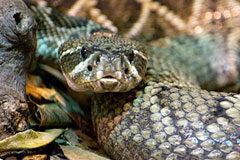
Location: North America, Stream Side
The venom of the cottonmouth is hemotoxic (like the copperhead) – breaking down and destroying blood cells and other tissues as well as reducing the bloods ability to clot – all resulting in massive hemorrhaging throughout the body of the victim. Reptiles and amphibians are often held onto for a few moments, giving the venom time to take effect; mammals are bitten and released (to reduce the chance of injury from an animal fighting back). Animals that do not die immediately are tracked down by scent.
Eastern Diamondback Rattlesnake
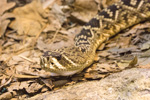
Location: North America, Stream Side
Largest venomous snake in North America. Very beneficial to man as they are effective natural pest controllers. Baby rattlesnakes can deliver a venomous bite that may be more severe than an adult’s bite. Young snakes cannot control the flow of venom as an adult can. Rattlesnake’s age is NOT evident by the number of segments on the rattle. Rattles will break off, and the animal’s shed more than once per year.
Elephant, African
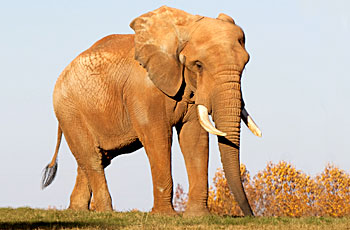
Location: African, Grasslands
Largest of all land mammals, African elephants may reach 13 feet tall and weigh over six tons (12,000 lbs). Their two impressive tusks are modified teeth and are used to pick things up, knock things over, and dig for water. They need them a lot more than we do!
Giraffe

Location: African, Forest Edge
The "Horns" are not really horns – bony lumps covered with skin and hair and called ossicones – only other animal to have them is the okapi (which is the only living relative of the giraffe).
Most giraffe have 2 ossicones, but some males may have up to 5. Easy way to tell male and female giraffes apart – males have larger “horns” and because they are used to fight, the hair on the ends is usually rubbed off. Females and young males have hair on top of their ossicones. Ossicones are flattened on newborns and pop up approximately one week after birth.
Gorilla, Western Lowland
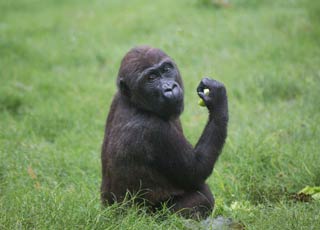
The gorillas will be fed daily at 11:30 a.m.
Location: African, Forest Glade
These primates have broad chests and are covered in black hairs which, in males, turn silver-grey on their backs as they age. Gorillas are typically peaceful animals, and western lowland gorillas live in small groups of often one dominant male, a few adult females, and their offspring. They forage on the ground for vegetation and build leaf nests to sleep in.
Greater Kudu
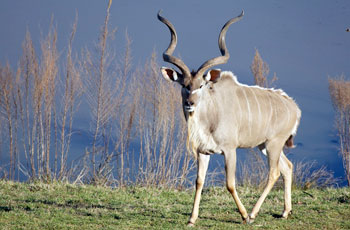
Location: African, Grasslands
The second tallest antelope (behind only the giant eland), its color varies from a tan-grey to bluish-grey with 6-10 vertical white stripes running along the body. Males darken with age and have a chevron of white between the eyes with a crest of hair runnning along the spine. Their horns are large and spiraling. Herds are made up of 6-10 females with their offspring and males are solitary or form bachelor herds of 2-10 animals. Males only join females herds to breed. Dominance among males is established through display, standing sideways in front of another and appearing as large as possible with fights only among same-sized individuals. They live in dense bush, forest, woodlands, other bushland.
Harbor Seal
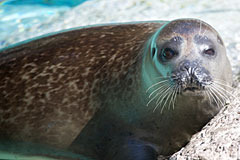
Feeding times are posted daily at the exhibit. Zookeepers normally post one to two feeding times.
Location: North America, Rocky Coast
Limbs are modified into flippers. Foreflippers have all the same skeletal features of land mammal forelimbs. These flippers are used to help steer underwater. They have noticeable, but short, blunt claws which are used for scratching, grooming, and defense. Hind flippers are webbed, and when spread, the hind flippers resemble a fan. Hind flippers are moved side-to-side to provide propulsion. All flippers are covered with hair.
Lion, African
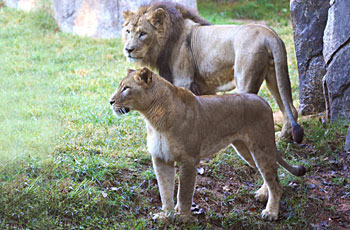
Location: African, African Lion Exhibit
No visit to our Africa region is complete unless you see our lions. These majestic cats will leave you roaring for more.
The roar of a male lion can be heard five miles away, and their mane is not only for demonstration, but protection in fights with other males and sometimes hyenas. Although males are called King of the Beasts, in a lion pride it is the females doing the hunting for the entire group.
Louisiana Pine Snake
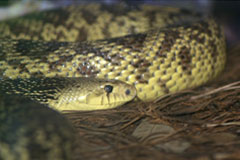
Location: North America, Cypress Swamp
The rarest snake in North America and one of the rarest vertebrates in the U.S. There may be as few as 75 animals left in the wild. The snake relys almost exclusively on Baird’s pocket gopher as a food source and lives within their burrow systems. The habitat is dependent on fire to maintan the pine forest and fire suppression has reduced quality pine snake habitat remarkably. Controlled burning is now in place in areas of Louisiana to restore the open understory of longleaf pine ecosystems. The species has the largest eggs and hatchlings of all North American snakes.
Marbled Salamander
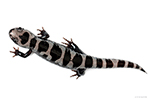
Location: North America, Cypress Swamp
A chunky, small salamander with white to light gray crossbands across the head and back, down to the tail. They are solitary and spend most of their time under leaf litter or even underground. They do defend their burrows against others. This salamander is found in most of the eastern United States, from MA to the Gulf States and to MO and TX. Unique among salamanders, they breed in the fall and do not breed in the water. Breeding occurs on land, in dried up ponds, pools and ditches. The eggs are deposited under leaves in these small depressions. They will hatch the following year when the area fills again with water. The female stays with the eggs to protect them and keep them moist. Breeding only happens once per year.
Nile Lechwe
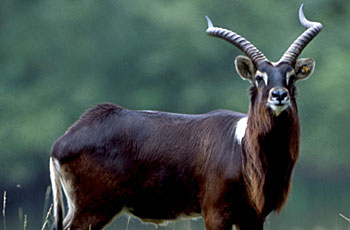
Location: African, Grasslands
Considered “royal” animals by the Shilluk people of Sudan, they and are important in sacred traditions within the culture. The species is have very dramatic sexual dimorphism, males are a dark chocolate with a white patch on their shoulders while the females are a uniform rufous color. A highly aquatic antelope, their large hooves help them move well in water, but they are somewhat clumsy on dry land. They are adept swimmers and quite agile in shallow waters, and will travel through the water in a series of leaps when they cannot swim.
Ostrich
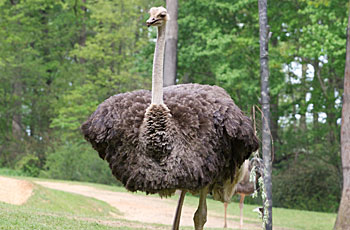
Location: African, Grasslands and Forest Edge Exhibits
The ostrich can weigh over 300 pounds and stand up to nine feet tall. Although they cannot fly, they can run at speeds over 45 MPH and use their wings to help maintain balance while running. Males court females through a dance that includes bowing to the ground, shaking his feathers, swaying back and forth and waving his wings and a red blush that covers their legs and neck.
Peregrine Falcon
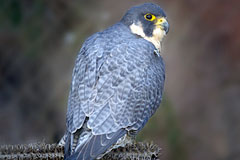
Location: North America, Rocky Coast
This falcon is one of the types of birds know as raptors or birds of prey. The name comes from raptus, meaning “to seize” and all raptors have hooked beaks and sharp talons. It was one of the most widespread birds in the world. The Peregrin falcon is the fastest living animal in the world, able to reach speeds of 200 MPH in a dive. Having been recently removed from the endagered list, its populations are still monitored.
Polar Bear
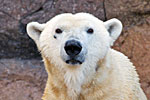
Location: North America, Rocky Coast
These iconic bears of the Arctic are the top predators of the north. They can weigh 1200 pounds and when standing, they might reach 11 feet tall. Their favorite food is ringed seals, and sometimes they only eat the energy rich fat, leaving the rest for others in the far north. They hunt and rest from the sea ice, so they need it to stay cold in the Arctic.
Red River Hogs
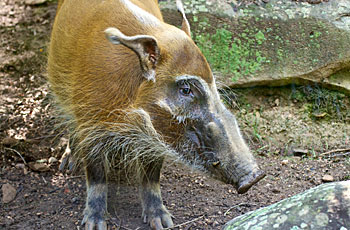
Location: African, Red River Hog Exhibit
These wild pigs are widely seen through the rainforests, thickets and savannas of western and central Africa. The animals get their name from their reddish color and because they are usually found near sources of water.
Also called the “tufted pig” due to the ear tassels and long white whiskers.The are covered in bristly red coat of hair with black and white markings on head and white rings around the eyes. A crest of white hair runs the length of the spine – this will stand erect when the animal is alarmed. Snout is long and, in males, has ridges and warts running lengthwise. Upper tusks are nearly invisible, but lower are sharp and can be three inches long. They possess an incredible sense of smell and hearing. When searching for food, they will sweep their snout over the ground in circular motions. Once food is located, the firm snout is again used, this time to root up the food. The sharp tusks are used to cut through woody roots and tubers. They can hear the movements of an earthworm under the ground.
Red-ruffed Lemur
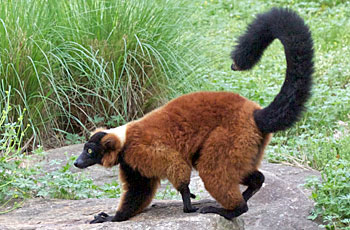
On Saturday and Sunday at 2:30 p.m., a keeper will perform a training session with the lemurs on exhibit and take questions from visitors at Lemur Island.
Location: African, Lemur Island
Found on the island of Madagascar off the east coast of Africa, the name of this primate comes from the Latin (lemures) meaning ghosts or spirit and was given to them by early explorers who were inspired by their haunting looks and calls. They spend most of their time in trees (arboreal) and live in small groups, numbering 5-6 adults. Communities can be larger, maybe reaching 30 or more. Larger groups form when food is plentiful, usually during the wet season. Like other lemurs, females are dominant within the groups. They rely on a wide variety of alarm calls to communicate danger to group members and are considered one of the most vocal non-human primates. Especially used to alert members to presence of predators, calls also used to maintain contact with other members and warn would-be competitors that might approach their territories. They depend on the sense of smell as another way to communicate with other animals. Special scent glands on the wrists and their bottoms are used to place scent marks on trees and branches to mark territory.
Ring-tailed Lemur
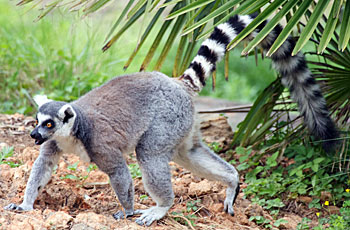
On Saturday and Sunday at 2:30 p.m., a keeper will perform a training session with the lemurs on exhibit and take questions from visitors at Lemur Island.
Location: African, Lemur Island
This primate is named for its distinctively black and white ringed tail. They are social animals, often grooming each other and eating together. In the morning they will “sunbathe” – sitting upright, exposing their bellies with front arms resting on their legs. As they travel, tails are held high, acting as flags to keep troop together. They are important in the ecosystem as seed dispersers, due to their diet of primarily fruit, and are unique among primates in Madagascar in how terrestrial they are, staying on the ground more than any other lemur. Scents is a powerful communication tool. Male R-T lemurs will engage in “stink fights”, especially during breeding season. During these duels, males will run their tails through the scent glands on their chest and wrists, getting them properly stinky. Then they will wave them at a rival to determine who is the dominant animal. Rivals will wave their tails back at the opponent or back down and run away. During the battles for dominance, each male tries to “outstink” the other.
River Otter
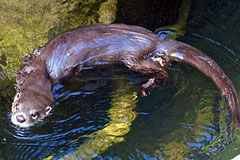
Location: North America, Stream Side
This aquatic mammal is streamlined with a powerful tail that helps push them through the water. Short, stiff whiskers pick up movement and obstacles underwater. The best habitat for them has a lot of plants, slow moving water and plenty of fish. They are sensitive to pollution and will leave polluted waterways if possible.
Sea Lion
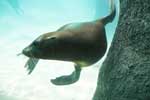
Location: North America, Rocky Coast
Feeding times are posted daily at the exhibit. Zookeepers normally post one to two feeding times.
The playful California sea lion is a very agile swimmer. They are distinguished from seals by having hind flippers that can rotate forward (allowing them to “walk” on land) and the presence of external ear flaps. This social marine mammal can dive 500 feet in search of squid, herring, mackerel and more. Our sea lions were stranded as pups and nursed back to health by caring people.
Sea Birds
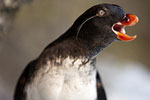
Location: North America, Rocky Coast
The seabirds are fed at 2:30 p.m. daily.
Sitatunga
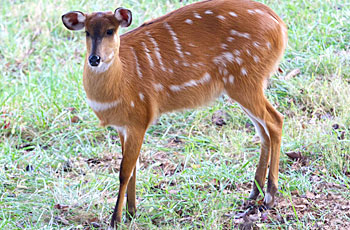
Location: African, Grasslands
Medium-sized antelope with a long and shaggy coat, covered in a water resistant oil – an adaptation to the aquatic lifestyle. Their coat color is rufous-red in females and young males and as males mature, their coat becomes more chocolate brown with a white dorsal stripe and growing a mane. Only males possess horns. East Africa’s only amphibious antelope, they live in thickly vegetated, muddy swamps, marshes and papyrus beds. They are good, but slow, swimmers, and will rest on floating mats of vegetation. Although usually standing half-submerged in water, if threatened they will flee to deeper waters and can submerge themselves so that only their nostrils showing.
Southern White Rhino
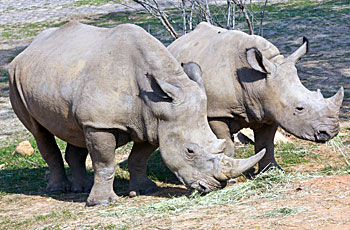
Location: African, Grasslands
White rhinos have very poor eyesight but an excellent sense of smell. White rhino home ranges are marked by dung heaps. These communal dung heaps, or middens, are usually located at territory boundaries and serve as a message board and provides a true and honest signal of health and status. For example, a male can discover if a female is ready to mate or subordinate males can tell that there is a dominant male close by. All animals add their deposits there.
Spotted Turtle
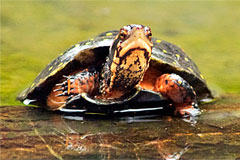
Location: North America, Stream Side
This species is named for yellow spots covering its shell and on its head, neck, and limbs. A small turtle with a broad, dark carapace, the shell has scattered yellow dots or spots. These yellow spots on the head, neck and limbs aid in identification. Males have brown eyes, a tan chin, and a long thick tail. Females have orange eyes, and a yellow chin. Active from March to October, they are often seen basking in the sun. They are highly aquatic and will bury themselves in response to a perceived threat. Omnivores, they eat snails, slugs, insects, small crayfish, worms, and spiders make up their diet. Also eat some vegetation including leaves, grasses, and seeds.
Thomson’s Gazelle
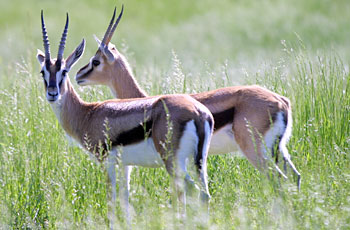
Location: African, Grasslands
When a Thomson's gazelle is faced with danger, it can run 40 miles per hour. While running, Thomson's gazelle occasionally jumps in the air with all four feet above the ground. This technique is also known as "pronking" or "stotting".
Two-toed Amphiuma
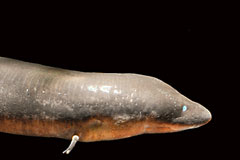
Location: North America, Stream Side
The two-toed amphiuma is the largest salamander in North America, reaching a length of four feet. All four limbs are present, but they are significantly reduced giving them an eel-like apperance.
Yellow Rat Snake
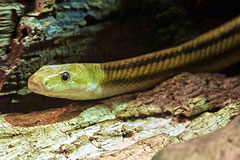
Location: North America, Stream Side
The snake is named for its healthy appetite for rodents. A non-venomous snake, this constrictor kills its prey by wrapping coils around it and squeezing with tremendous force, cutting off their air supply and even limiting blood flow. Truly arboreal snakes, they climb very well, and may reach heights of 60 ft in search of birds or bird eggs. The belly scales are more square, helping with climbing. When not in trees they are often found under boards, in leaf litter and under rocks and also spend a lot of time in rodent burrows, pursuing prey. When threatened they will freeze.
Zebra

Location: African, Forest Edge
No two zebra have the same pattern of stripes, just like the fingerprints of people. The stripes provide camouflage in the grasslands and might make it difficult to pick out individual animals in a herd. They feed on the tall, tougher grasses, leaving behind the softer shoots for other grazers.
© North Carolina Zoo